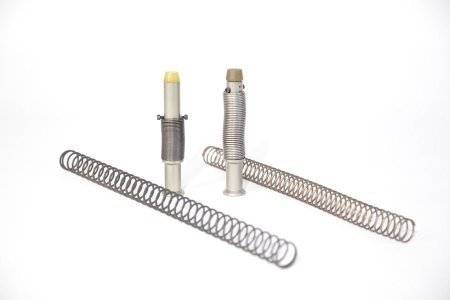@Droppoint
And right there with you on the "no pissing match"... so many people think what works for one person.. should work everytime.. typically forgetting there are many more variables involved.
here is my experience with 308 springs in my 9MM PCC
308 Tubbs Flatwire recoil spring in my 16" and 11.5" Colt Pattern PCC AR's
The OEM spring and buffer weight felt like the blowback action was beating the crap out of the firearm. Both barrel lengths.
After changing to a 7.5oz buffer and the Tubbs 308, the difference was considerably better.
Far less Linda Blair ( the Exorcist ) recoil impulse and much, much more Winnie the Pooh. ( Oh bother.. and silly comment, but you get what I mean. )
I like it so much I did the same thing to my 11.5" pistol setup, with EndoMags.
JP Enterprises recommends their 308 recoil spring as well.... I haven't tried those though.
To directly respond to some of your questions...
And what barrel length are you using ? That might be a factor in the use of a 308 recoil spring.
"- Reduce the time available for reliable ejection".... the only ejection issue I have ever had was with a brass catcher, believe it or not , the catcher was bouncing the case back into the action... a slight adjustment , fixed it.
"- Reportedly cause more dot/muzzle movement (unconfirmed)" I tired a LOT of recoil setups ( various buffer weights and recoil springs )... clear up to a 10oz buffer weight and a Sprinco AR-10 Orange Extra Power... that specific setup would cause very, very obvious muzzle dip.
And I instantly thought about how I had just moved the Linda Blair perceived recoil to the other end of the firearm. Needless to say, great learning experience.. waste of money.
"- Make it slightly more difficult to charge the firearm"... With the Tubbs 308 spring, I don't notice it at all. FWIW, the Tubbs has slightly increased bolt closed ft/lb, and normalish function ft/lbs.
I will see if I can find the "chart" showing the ft/lb differences in the various 308 and 5.56 recoil springs.... Found it.
A2 (old) - 7.6lb closed, 14.5lb open
A2 (new) - 9.1lb closed, 16.7lb open
Tubb Flatwire - 10.5lb closed, 16.3lb open
Tubb .308 Flatwire - 13lb closed, 16.7lb open
SpringCo White ? (standard) - 8.3lb closed, 16.3lb open
SpringCo Red (extra) - 10.5lb closed, 18.4lb open
SpringCo Orange (increased) - 13.9lb closed, 24.8lb open
And a comment concerning the Tubbs 308 spring...
"If those are accurate then the .308 flatwire only has a higher spring rate when the bolt is closed which is where you would want it for the a blockback 9mm. With the spring rate being about the same for open I would think the bolt velocity would be about the same."
Given those various different 308 spring weights, I would think everyone could have completely different experiences with their chosen buffer weight, and believe it or not, their actual physical size. ( Weight )
"- Reportedly reduce perceived recoil by decelerating the bolt rearward travel quicker (unconfirmed)" .....See Linda Blair v. Winnie the Pooh comment above.
"- Are sometimes used by individuals to reduce bolt overtravel with coil bind (!!!) instead of using an extended buffer" .... can't happen with the Tubbs Flatwire, flatwire recoil spring take up far less space.

"- Reportedly cause additional wear/battering of parts (unconfirmed)"..... can't say I have seen any additional wear.
FWIW... here is a ton of Chrono data from the 308 Tubbs Recoil spring 16" setup... ( I can't say I would have pursued this if I had used the OEM 5.56 standard recoil spring and typical 9MM buffer weight. I KNOW, I would have wondered if I was beating my 9MM PCC to death through all the testing.
https://www.ar15.com/forums/ar-15/-/16-712312/?page=1&anc=7429025#i7429025
 Win a FREE Membership!
Win a FREE Membership!